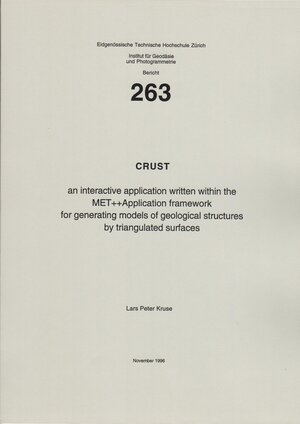
×
![Buchcover ISBN 9783906513898]()
CRUST an interactive application written within the MET++ Application framework for generating models of geological structures by triangulated surfaces
von L P Kruse, Vorwort von H G KahleThe aim of gravity modeling in geodesy is to compute the geoid height and the deflection of the vertical at any point on the surface and to calculate the gravitational influence on satellite orbits in space. A density distribution model that fits surface measurements is not automatically suited for extrapolation in space, this is due to the solution ambiguity from potential field data. To constrain the solution within certain limits and to obtain a reasonable solution from a geological/geophysical point of view the use of geophysical and geological data is essential. Furthermore good modeling of geological structures allows us to increase the accuracy and to reduce the model ambiguity.
A main part of 3-dimensional geometrical modeling consists of visualization, since the amount of data points often exceeds several thousands. Visual control is essential to avoid overlapping of, or gaps between auxiliary surfaces as well as to correct failure before calculation are carried out on such structures. In times where no visualization software was available, modeling was a lengthy construction task and mainly carried out to get a better insight in complicated geometry and geodynamics.
Another aspect of 3D modeling is the visual handling of large data sets. By interacting with presented visual information, users get computer-supported semantic feedback that provides insight and understanding far better than static descriptions. The CRUST application, presented in this report is an integrated part of the MET ++ application framework [Weinand A. et. al., 1994], [Ackermann P, 1996]. MET++ was developed at the Multi Media Lab. University of Zurich. MET++ is a fully object-oriented pplication framework written in C++ that supports spatial and temporal composition of text, 2D, 3D graphics, video, audio and music. The CRUST application uses the 3D graphics part of MET++ with all built-in features inherited from the application framework such as cut, copy, paste, move, rotate, etc. Editors for camera and light positioning, 3D objects, materials, texture mapping, printing, etc. A so called simple3D Sample Application can be written with about 30 lines of C++ code within MET++.
CRUST was designed for geometrical modeling of geological structures and to meet the needs of the FORTRAN pro gram POTENZ [F. Arnet, 1992] which ca1culates the gravity effect and related quantities of bodies bounded by polygons. To do this, the following programming extensions was made:
A main part of 3-dimensional geometrical modeling consists of visualization, since the amount of data points often exceeds several thousands. Visual control is essential to avoid overlapping of, or gaps between auxiliary surfaces as well as to correct failure before calculation are carried out on such structures. In times where no visualization software was available, modeling was a lengthy construction task and mainly carried out to get a better insight in complicated geometry and geodynamics.
Another aspect of 3D modeling is the visual handling of large data sets. By interacting with presented visual information, users get computer-supported semantic feedback that provides insight and understanding far better than static descriptions. The CRUST application, presented in this report is an integrated part of the MET ++ application framework [Weinand A. et. al., 1994], [Ackermann P, 1996]. MET++ was developed at the Multi Media Lab. University of Zurich. MET++ is a fully object-oriented pplication framework written in C++ that supports spatial and temporal composition of text, 2D, 3D graphics, video, audio and music. The CRUST application uses the 3D graphics part of MET++ with all built-in features inherited from the application framework such as cut, copy, paste, move, rotate, etc. Editors for camera and light positioning, 3D objects, materials, texture mapping, printing, etc. A so called simple3D Sample Application can be written with about 30 lines of C++ code within MET++.
CRUST was designed for geometrical modeling of geological structures and to meet the needs of the FORTRAN pro gram POTENZ [F. Arnet, 1992] which ca1culates the gravity effect and related quantities of bodies bounded by polygons. To do this, the following programming extensions was made:
- input and output converters
- 2D Delaunay triangulation of 3D points
- editing the triangulation
- generation of 2D profile
- generation of bodies bounded by triangulated surfaces


